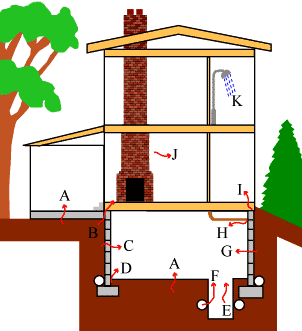Do It Yourself Radon Decrease System Tips
As early as 1990 some residences have actually been built using radon-resistant materials as well as with pre-piped radon reduction systems mounted. Tidy gravel "air movement layers", vapor barriers, additional polyurethane caulking, as well as air vent pipelines are all widely made use of.
Can you reduce radon by opening windows?
In most cases, pros charge about $1,500 to install a radon mitigation system, but you can do it yourself for only about $500 in materials. So if you're fairly handy and have some carpentry, plumbing and electrical skills, you can install your own system in a weekend and save yourself a thousand bucks!
The objective of the radon reduction system is to reduce the interior radon degree as low as sensibly achievable. All systems ought to minimize radon listed below the EPA activity level of 4 pCi/L (picocuries of radon per litre of air).
- Depending upon your geographical area, the radon degrees of the air you breathe beyond your house may be as high as 0.75 pCi/L.
- The United States EPA has actually put it clearly, stating, "Any type of radon exposure has some risk of causing lung cancer cells.
- Your threat of lung cancer boosts considerably with direct exposure to greater radon levels.
- Radon gas is a naturally-occurring byproduct of the contaminated decay of Uranium in the dirt.

Do radon mitigation systems really work?

The cost of a mitigation system may vary according to the home's design, size, foundation, construction materials and the local climate. Radon reduction systems average costs nationally are $1,200 with a range from $800 to $1500 common depending on house and market conditions.
Remember to test for radon gas in numerous seasons throughout the year since the weather condition can have an impact on the outcomes. You don't desire the perception that you are "risk-free" since you tested during a reduced period yet your radon levels are actually quite high during various other durations. Likewise, If you have a radon reduction system in your house, do not assume it is functioning appropriately based upon the one test that you did right after the system was set up. Re-test any house with or without a radon mitigation system a minimum of every 2 years.
The EPA approximates that a radon removal system costs concerning $1,200 for a typical home. The system is usually consisted of one or more PVC pipelines that range from the radon-emitting dirt under a residence up via the roof.
The United States EPA has put it clearly, specifying, "Any kind of radon exposure has some danger of creating lung cancer. Radon gas is https://radon1.com a naturally-occurring by-product of the radioactive degeneration of Uranium in the dirt.
The heavy-hitting solution to lowering radon levels is to install a reduction system. Integrate polonium with restricted indoor air high quality with existing radon gas; inhale both substances and the threat factor of creating lung cancer cells is raised by an element of 8.3. Levels over 4 pCi/L are considered actionable, so those are in the unsafe levels of radon for indoors. Radon is a contaminated gas that is so widespread, we're exposed to it daily. It just becomes dangerous when it gathers to certain degrees, enhancing the risk of lung cancer cells, states the National Cancer Institute (NCI) in Bethesda, Maryland.
All Homes Can be Dealt With
Others combine the experience of their technicians to state "+ years experience" yet the company hasn't been around very long. If they do not tell you the full reality on their level of experience, can you trust them to inform you the fact concerning anything else?
Who pays for radon mitigation?
The Surgeon General and the EPA recommend testing for radon and reducing radon in homes that have high levels. Fix your home if your radon level is confirmed to be 4 picocuries per liter (pCi/L) or higher. Radon reduction systems work. Some radon reduction systems can reduce radon levels in your home by up to 99%.
